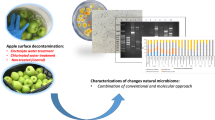Abstract
Alicyclobacilli were isolated from orchard soil collected from an apple and pear farm in Elgin, Western Cape, South Africa. Morphological, biochemical and physiological characteristics of the isolates were used to presumptively classify them as belonging to the genus Alicyclobacillus. Strains were identified to species level by polymerase chain reaction (PCR) with genus-specific primers, and 16S ribosomal RNA (rRNA) gene sequencing. To our knowledge this is the first report on the isolation of Alicyclobacillus acidoterrestris and Alicyclobacillus acidocaldarius from orchard soil. The presence of these organisms in the soil suggests a possible source of contamination for the final fruit juice, concentrate or pulp.
Similar content being viewed by others
References
Albuquerque L, Rainey FA, Chung AP, Sunna A, Nobre MF, Grote R, Antranikian G, da Costa MS (2000) Alicyclobacillus hesperidum sp. nov. and a related genomic species from solfataric soils of São Miguel in the Azores. Int J Syst Evol Microbiol 50:451–457
Chang S, Kang D-H (2004) Alicyclobacillus spp. in the fruit juice industry: history, characteristics, and current isloation/detection procedures. Crit Rev Microbiol 30:55–74
Connor CJ, Luo H, McSpadden B, Gardener B, Wang HH (2005) Development of a real-time PCR-based system targeting the 16S rRNA gene sequence for rapid detection of Alicyclobacillus spp. in juice products. Int J Food Microbiol 99:229–235
Deinhard G, Blanz P, Poralla K, Altan E (1987) Bacillus acidoterrestris sp. nov.: a new thermo tolerant acidophile isolated from different soils. Syst Appl Microbiol 10:47–53
Eiora MN, Junqueira VC, Schmidt FL (1999) Alicyclobacillus in orange juice: occurrence and heat resistance of spores. J Food Prot 62:883–886
Felske A, Rheims H, Wolterink A, Stackebrant E, Akkermans ADL (1997) Ribosome analysis reveals prominent activity of an uncultured member of the class Acinetobacteria in grasslands soil. Microbiology 143:2983–2989
Garbers I-M, Britz TJ, Witthuhn RC (2004) PCR-based denaturing gradient gel electrophoretic typification and identification of microbial consortium present in Kefir grains. World J Microbiol Biotechnol 20:687–693
Goto K, Mochida K, Tanimoto Y, Tamura T, Tanaka H, Suzuki M, Hara Y, Yamasato K, Inagaki K (2001) Identification of thermoacidophilic bacteria (Alicyclobacillus) isolated from food and acidic environment. American Society for Microbiology, vol 101. General meeting abstract, pp 580 (P115)
Goto K, Tanimoto Y, Tamura T, Mochida K, Arai D, Asahara M, Suzuki M, Tanaka H, Inagaki K (2002) Identification of thermo-acidophilic bacteria and a new Alicyclobacillus genomic species isolated from acidic environments in Japan. Extremophiles 6:333–340
Goto K, Moshida K, Asahara M, Suzuki M, Kasai H, Yokota A (2003) Alicyclobacillus pomorum sp. nov., a novel thermo-acidophillic, endospore-forming bacterium that does not possess omega-alicyclic fatty acids, and emended description of the genus Alicyclobacillus. Int J Syst Evol Microbiol 53:1537–1544
Gouws PA, Gie L, Pretorius A, Dhansay N (2005) Isolation and identification of Alicyclobacillus acidocaldarius by 16S rDNA from mango juice and concentrate. Int J Food Sci Technol 40:789–792
Harrigan WF, McCance ME (1976) Laboratory methods in food and dairy microbiology. Academic, New York, p 42
Jensen N (1999) Alicyclobacillus- a new challenge for the food industry. Food Aust 51:33–36
Jensen N (2000) Alicyclobacillus in Australia. Food Aust 52:282–285
Jensen N, Whitfield FB (2003) Role of Alicyclobacillus acidoterrestris in the development of a disinfectant taint in shelf-stable fruit juice. Lett Appl Microbiol 36:9–14
Matsubara H, Goto K, Matsumura T, Mochida K, Iwaki M, Niwa M, Yamasoato K (2002) Alicyclobacillus acidiphilus sp.nov., a novel thermo-acidophilic, ω-alicyclic fatty acid-containing bacterium isolated from acidic beverages. Int J Syst Evol Microbiol 52:1681–1685
McIntyre S, Ikawa JY, Parkinson N, Haglund J, Lee J (1995) Characterization of an acidophilic Bacillus strain isolated from shelf-stable juices. J Food Prot 58:319–321
Orr RV, Beuchat LR (2000) Efficiency of disinfectants in killing spores of Alicyclobacillus acidoterrestris and performance of media for supporting colony development by survivors. J Food Prot 63:1117–1122
Pettipher GL, Osmundsen ME, Murphy JM (1997) Methods for the detection and enumeration of Alicyclobacillus acidoterretris and investigation of growth and production of taint in fruit juice and fruit juice-containing drinks. Lett Appl Microbiol 24:185–189
Pontius AJ, Rushing JE, Foegeding PM (1998) Heat resistance of Alicyclobacillus acidoterrestris spores as affected by various pH values and organic acids. J Food Prot 61:41–46
Silva FVM, Gibbs P (2001) Alicyclobacillus acidoterrestris spores in fruit products and design of pasteurization processes. Trends Food Sci Technol 12:68–74
Splittstoesser DF, Churey JJ, Lee CY (1994) Growth characteristics of aciduric sporeforming bacilli isolated from fruit juices. J Food Prot 57:1080–1083
Splittstoesser DF, Lee CY, Churey JJ (1998) Control of Alicyclobacillus in the juice industry. Dairy Food Enviorn Sanit 18:585–587
Uchino F, Doi S (1967) Acido-thermophillic bacteria from thermal waters. Agric Biol Chem 31:817–822
Walls I, Chuyate R (1998) Alicyclobacillus- historical perspective and preliminary characterization study. Dairy Food Environ Sanit 18:499–503
Walls I, Chuyate R (2000) Isolation of Alicyclobacillus acidoterrestris from fruit juices. J AOAC Int 83:1115–1120
Wisotzkey JD, Jurtshuk P, Fox GE, Deinhart G, Poralla K (1992) Comparative sequence analyses on the 16S rRNA (rDNA) of Bacillus acidocaldarius, Bacillus acidoterrestris, and Bacillus cycloheptanicus and proposal for creation of a new genus, Alicyclobacillus gen. nov. Int J Syst Bacteriol 42:263–269
Yamazaki K, Teduka H, Shinano H (1996) Isolation and identification of Alicyclobacillus acidoterrestris from acidic beverages. Biosci Biotech Biochem 60:543–545
Acknowledgments
We gratefully acknowledge the National Research Foundation (RSA), PA and A Malan Trust and Stellenbosch University for their financial support.
Author information
Authors and Affiliations
Corresponding author
Additional information
Communicated by D. A. Cowan.
Rights and permissions
About this article
Cite this article
Groenewald, W.H., Gouws, P.A. & Witthuhn, R.C. Isolation and identification of species of Alicyclobacillus from orchard soil in the Western Cape, South Africa. Extremophiles 12, 159–163 (2008). https://doi.org/10.1007/s00792-007-0112-z
Received:
Accepted:
Published:
Issue Date:
DOI: https://doi.org/10.1007/s00792-007-0112-z




